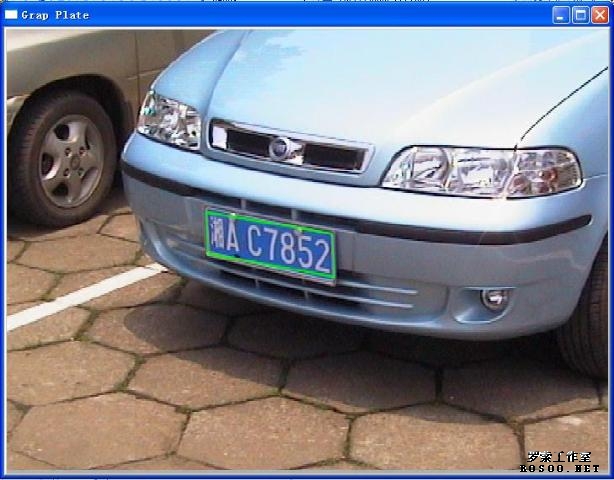车牌定位算法在车牌识别技术中占有很重要地位,一个车牌识别系统的识别率往往取决于车牌定位的成功率及准确度。
车牌定位有很多种算法,从最简单的来,车牌在图像中一般被认为是长方形,由于图像摄取角度不同也可能是四边形。我们可以使用OpenCV中的实例: C:\Program Files\OpenCV\samples\c.squares.c 这是一个搜索图片中矩形的一个算法。我们只要稍微修改一下就可以实现定位车牌。
在这个实例中使用了canny算法进行边缘检测,然后二值化,接着用cvFindContours搜索轮廓,最后从找到的轮廓中根据角点的个数,角的度数和轮廓大小确定,矩形位置。以下是效果图:

这个算法可以找到一些车牌位置,但在复杂噪声背景下,或者车牌图像灰度与背景相差不大就很难定位车牌
所以我们需要寻找更好的定位算法。下面是squares的代码:
- #ifdef _CH_
- #pragma package <opencv>
- #endif
-
- #ifndef _EiC
- #include "cv.h"
- #include "highgui.h"
- #include <stdio.h>
- #include <math.h>
- #include <string.h>
- #endif
-
- int thresh = 50;
- IplImage* img = 0;
- IplImage* img0 = 0;
- CvMemStorage* storage = 0;
- CvPoint pt[4];
- const char* wndname = "Square Detection Demo";
-
-
-
-
- double angle( CvPoint* pt1, CvPoint* pt2, CvPoint* pt0 )
- {
- double dx1 = pt1->x - pt0->x;
- double dy1 = pt1->y - pt0->y;
- double dx2 = pt2->x - pt0->x;
- double dy2 = pt2->y - pt0->y;
- return (dx1*dx2 + dy1*dy2)/sqrt((dx1*dx1 + dy1*dy1)*(dx2*dx2 + dy2*dy2) + 1e-10);
- }
-
-
-
- CvSeq* findSquares4( IplImage* img, CvMemStorage* storage )
- {
- CvSeq* contours;
- int i, c, l, N = 11;
- CvSize sz = cvSize( img->width & -2, img->height & -2 );
- IplImage* timg = cvCloneImage( img );
- IplImage* gray = cvCreateImage( sz, 8, 1 );
- IplImage* pyr = cvCreateImage( cvSize(sz.width/2, sz.height/2), 8, 3 );
- IplImage* tgray;
- CvSeq* result;
- double s, t;
-
-
- CvSeq* squares = cvCreateSeq( 0, sizeof(CvSeq), sizeof(CvPoint), storage );
-
-
-
- cvSetImageROI( timg, cvRect( 0, 0, sz.width, sz.height ));
-
-
- cvPyrDown( timg, pyr, 7 );
- cvPyrUp( pyr, timg, 7 );
- tgray = cvCreateImage( sz, 8, 1 );
-
-
- for( c = 0; c < 3; c++ )
- {
-
- cvSetImageCOI( timg, c+1 );
- cvCopy( timg, tgray, 0 );
-
-
- for( l = 0; l < N; l++ )
- {
-
-
- if( l == 0 )
- {
-
-
- cvCanny( tgray, gray,60, 180, 3 );
-
-
- cvDilate( gray, gray, 0, 1 );
- }
- else
- {
-
-
-
- cvThreshold( tgray, gray, 50, 255, CV_THRESH_BINARY );
- }
-
-
- cvFindContours( gray, storage, &contours, sizeof(CvContour),
- CV_RETR_LIST, CV_CHAIN_APPROX_SIMPLE, cvPoint(0,0) );
-
-
-
- while( contours )
- {
-
-
- result = cvApproxPoly( contours, sizeof(CvContour), storage,
- CV_POLY_APPROX_DP, cvContourPerimeter(contours)*0.02, 0 );
-
-
-
-
-
-
- if( result->total == 4 &&
- fabs(cvContourArea(result,CV_WHOLE_SEQ)) > 1000 &&
- cvCheckContourConvexity(result) )
- {
- s = 0;
-
- for( i = 0; i < 5; i++ )
- {
-
-
- if( i >= 2 )
- {
- t = fabs(angle(
- (CvPoint*)cvGetSeqElem( result, i ),
- (CvPoint*)cvGetSeqElem( result, i-2 ),
- (CvPoint*)cvGetSeqElem( result, i-1 )));
- s = s > t ? s : t;
- }
- }
-
-
-
-
-
- if( s < 0.3 )
- for( i = 0; i < 4; i++ )
- cvSeqPush( squares,
- (CvPoint*)cvGetSeqElem( result, i ));
- }
-
-
- contours = contours->h_next;
- }
- }
- }
-
-
- cvReleaseImage( &gray );
- cvReleaseImage( &pyr );
- cvReleaseImage( &tgray );
- cvReleaseImage( &timg );
-
- return squares;
- }
-
-
-
- void drawSquares( IplImage* img, CvSeq* squares )
- {
- CvSeqReader reader;
- IplImage* cpy = cvCloneImage( img );
- int i;
-
-
- cvStartReadSeq( squares, &reader, 0 );
-
-
- for( i = 0; i < squares->total; i += 4 )
- {
- CvPoint* rect = pt;
- int count = 4;
-
-
- memcpy( pt, reader.ptr, squares->elem_size );
- CV_NEXT_SEQ_ELEM( squares->elem_size, reader );
- memcpy( pt + 1, reader.ptr, squares->elem_size );
- CV_NEXT_SEQ_ELEM( squares->elem_size, reader );
- memcpy( pt + 2, reader.ptr, squares->elem_size );
- CV_NEXT_SEQ_ELEM( squares->elem_size, reader );
- memcpy( pt + 3, reader.ptr, squares->elem_size );
- CV_NEXT_SEQ_ELEM( squares->elem_size, reader );
-
-
- cvPolyLine( cpy, &rect, &count, 1, 1, CV_RGB(0,255,0), 3, CV_AA, 0 );
- }
-
-
- cvShowImage( wndname, cpy );
- cvReleaseImage( &cpy );
- }
-
-
- void on_trackbar( int a )
- {
- if( img )
- drawSquares( img, findSquares4( img, storage ) );
- }
-
- char* names[] = { "pic1.png", "pic2.png", "pic3.png",
- "pic4.png", "pic5.png", "pic6.png", 0 };
-
- int main(int argc, char** argv)
- {
- int i, c;
-
- storage = cvCreateMemStorage(0);
-
- for( i = 0; names[i] != 0; i++ )
- {
-
- img0 = cvLoadImage( names[i], 1 );
- if( !img0 )
- {
- printf("Couldn't load %s\n", names[i] );
- continue;
- }
- img = cvCloneImage( img0 );
-
-
-
- cvNamedWindow( wndname,0 );
- cvCreateTrackbar( "canny thresh", wndname, &thresh, 1000, on_trackbar );
-
-
- on_trackbar(0);
-
-
- c = cvWaitKey(0);
-
- cvReleaseImage( &img );
- cvReleaseImage( &img0 );
-
- cvClearMemStorage( storage );
- if( c == 27 )break;
- }
- cvDestroyWindow( wndname );
- return 0;
- }
-
- #ifdef _EiC
- main(1,"squares.c");
- #endif
原文:http://blog.csdn.net/heihei723/
(heihei723) |
